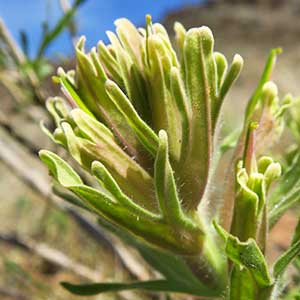Castilleja xanthotricha
Castilleja lacera
John Day or yellow-hairy paintbrush, John Day paintbrush, yellow hair paintbrush, yellow-hair Indian paintbrush
cut-leaf owl's clover, cut-leaf paintbrush, cutleaf Indian paintbrush, foothill owl's clover
few to several, ± decumbent to erect or ascending, unbranched, sometimes with short, leafy axillary shoots, hairs erect to spreading, long, soft, eglandular, mixed with short stipitate-glandular ones.
solitary, erect, unbranched or branched, hairs spreading, long, soft, scattered among more numerous, medium length, stipitate-glandular ones.
green, linear, lanceolate to broadly lanceolate, oblong, or cuneate, 0.8–5 cm, not fleshy, margins plane to wavy, involute, 0–5-lobed, apex acute, sometimes rounded;
lobes spreading, linear, arising below mid length, nearly as broad as center lobe, apex acute.
green or purplish, linear to narrowly lanceolate, 1–5 cm, not fleshy, margins plane, flat, 0–5(–7)-lobed, apex acuminate;
lobes spreading to ascending, linear, apex acuminate to acute.
3–14 × 1.5–4.5 cm;
bracts proximally greenish, rarely dull reddish purple, distally white to cream, rarely pale yellow or dull, pale pink (sharply differentiated from proximal coloration), lanceolate or oblong to narrowly ovate, (3–)5–7-lobed;
lobes ascending, linear to obovate, ± broadened distally, medium, long, proximal lobes arising below mid length, central lobe apex broadly rounded to truncate, others acute to rounded.
(1.5–)3–14 × 2–3 cm;
bracts green throughout, sometimes proximally green, distally white on apices, lanceolate to ovate, 3–7-lobed;
lobes spreading to ascending, linear to narrowly lanceolate, long, arising below mid length, apex obtuse to acute.
curved, 17–23 mm;
tube 15–19 mm;
beak exserted, adaxially green, 5–8(–9) mm, puberulent, stipitate-glandular;
abaxial lip deep purple (color sometimes visible through calyx), green, pinkish, or pale yellow, ± prominent, slightly inflated, usually hidden in calyx, sometimes right at top of calyx, 2 mm, ca. 50% as long as beak;
teeth ascending, whitish, yellowish, pink, or green, 1–1.5 mm.
straight, 10–22 mm;
tube 8–15 mm;
abaxial lip and beak exserted;
beak adaxially yellow to greenish, 3–6 mm, densely puberulent;
abaxial lip yellow with purple dots at base, inflated, pouches 3, central pouch slightly 2-lobed, pouches 4–8 mm wide, 3–6 mm deep, side pouches curving up a little at tip, 2–5 mm, 75–95% as long as beak;
teeth erect, white or yellow, 0.5–2 mm.
colored as bracts, 15–26 mm;
abaxial and adaxial clefts 3.5–7 mm, 25–50% of calyx length, deeper than laterals, lateral 2–5 mm, 12–25% of calyx length;
lobes linear, oblong, or narrowly triangular, center lobe apex usually rounded, lobes acute to rounded.
light green, lobes green, 7–13 mm;
abaxial and adaxial clefts 3.5–8 mm, 50–67% of calyx length, lateral 2.5–5 mm, ca. 40% of calyx length;
lobes narrowly to broadly lanceolate, apex acute to acuminate.
equal to or slightly exserted from beak.
= 48.
= 22, 24.
Castilleja xanthotricha
Castilleja lacera
Castilleja xanthotricha is endemic to moderate elevations in the sagebrush hills of the John Day River drainage in north-central Oregon. N. H. Holmgren (1971) hypothesized that this tetraploid species is of allopolyploid hybrid origin between C. glandulifera and C. oresbia.
(Discussion copyrighted by Flora of North America; reprinted with permission.)
Castilleja lacera is found in a wide range of elevations in the central and northern Sierra Nevada region and in the Siskiyou Mountains region of northwestern California and southwestern Oregon. Reports from the Coast Ranges north of the San Francisco Bay region and south of the Siskiyou region in western California are referable to other yellow-flowered annuals, including C. ambigua, C. rubicundula var. lithospermoides, Triphysaria eriantha subsp. eriantha, and T. versicolor subsp. faucibarbata. Although most similar to C. rubicundula, C. lacera is somewhat smaller in stature and flower size. It is also easily confused with yellow-flowered populations of C. tenuis, which has smaller flowers and an included stigma. Two chromosome numbers are known for this species, the more northern populations being diploid, and those to the south having an apparently aneuploid count of 2n = 22, which is unique in the genus.
(Discussion copyrighted by Flora of North America; reprinted with permission.)


